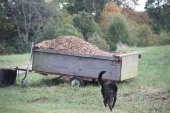Konrad Schreiber is a french agronomist, and in these 12 videos he's training market gardeners to produce organic vegetables using mulch. Videos in french but try using auto-translated subtitles... my comments and question in italics.
1) Introduction:
How come how plants grow on their own, but the current agricultural techniques have led to a diminishing return?
He will present the current agrological research, developed with farmers in France.
2) Understanding the carbon - nitrogen cycle
The goal - to reach the maximum vegetative yield
Example - goosefoot (weed) will take up available nitrogen (N) from soil and produce carbon (C) (which is exactly the opposite of what agriculture does)
hypothesis: it is carbon that drives plant productivity. It is not soil that is the issue, since plants grow everywhere, but plants are the key. There is a huge variability in plant species, meaning that it is possible to choose adapted plants for whatever growing situation.
Biological succession leads to maximum vegetative yield.
First phase are annuals, that take up the available nitrogen and produce straw = carbon uptake
Next phase are the leguminous pioneer plants, some annual but most perennial. They take up nitrogen from the air to produce more straw = C x10, N +1 (lots more carbon, some nitrogen returned to soil)
Third phase: brambles and pioneer trees
Climax: trees
The system produces more and more carbon (lignin), all without nitrates.
Therefore, it is not N which is the limiting factor, as it is available almost unlimited in the air.
The driving factor is carbon.
How does a tree grow? Breathes N, "execretes" C in the form of lignin in the trunk. Leaves = 50% cellulose, 50% lignin which is almost exactly the composition of ramial wood chips (RWC)
cellulose = "fast carbs" , more nitrogen, carbon stable
lignin = "slow carbs" , less nitrogen, lots more carbon. Lignin is an interesting food source because every C-C link releases energy when its broken. Cellulose to start the engine, lignin to keep it going.
Living beings breathe, eat, digest, and defecate in one form or another. Human beings eat carbon and therefore you will find carbon in their digestion and defecation. We inhale O2 and exhale CO2, but also a whole lot of N (80% of air), which is why we find nitrogen in the execretions. We live of nitrogen.
This is not true of animals - N is in what they eat! He clearly understands plants, but not humans... his examples are therefore incorrect, but his arguments as far as plants are concerned is interesting.
He then argues that the essential ingredient is carbon, because nitrogen is available in the air.
He tells of his experiments with RWC, things were growing, but they could not find nitrates in the soil to explain the growth.
Consider soil as an organism, that breathes N, eats C, digests C and NH3, excretes C and N. Therefore the soil of your field needs to breathe, and eat C, so that the result is a soil with more N. In order to increase soil nitrogen, it is necessary to add carbon.

 1
1




 1
1




 1
1




 1
1




 1
1




 1
1




 1
1







